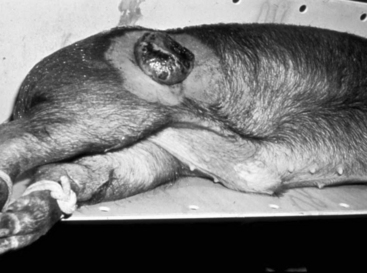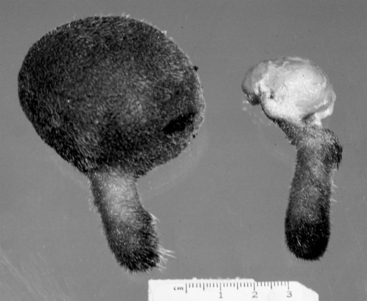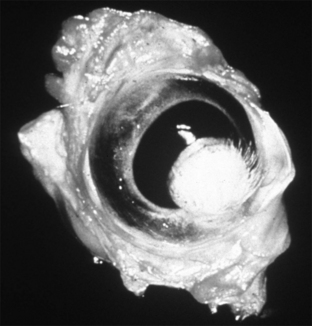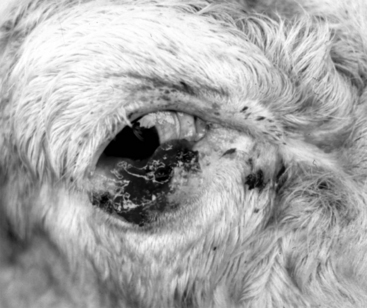Chapter 3 Neoplasia
The description of neoplastic disorders and incidence of neoplasia in farm animals has historically relied heavily on surveys conducted on animals at slaughter houses. The incidence of tumors reported in such surveys indicates that tumors are most common in cattle (0.23%) and are uncommon in sheep (0.002%), goats (0.009%), and pigs (0.004%).
Tumors of the Skin and Soft Tissue
PAPILLOMA AND FIBROPAPILLOMA (PAPILLOMATOSIS)
Bovine papillomas can become quite large and multinodular. They may be broad-based or pedunculated. They are alopecic and surface hyperkeratosis is typical. Exophytic growths are most common, although flat plaque-like growths are also possible. Lesions can occur anywhere on the body, but the head, neck and dewlap are common sites (Figure 3-1). In sheep, papillomatosis most often involves the skin of the face and legs. Goat papillomas most often occur on the head, neck, shoulders, and upper forelegs.

Figure 3-1 Multiple papillomas caused by bovine papillomavirus on the muzzle and lips of a young cow.
(Courtesy of Dr. Stan Snyder.)
SQUAMOUS CELL CARCINOMA
Cutaneous squamous cell carcinoma causes a raised, proliferative, and ulcerated lesion and in cattle is most common at mucocutaneous junctions, such as the periocular skin and skin of the vulva. Squamous cell carcinoma in the skin of Merino sheep most often occurs on the ears and less commonly involves the muzzle, lower lip, and vulva. Those on the vulva occur primarily in sheep in which perineal surgery has been performed to reduce fly strike. Tumors in sheep are often multicentric. Squamous cell carcinoma of the ears of sheep can begin as a cutaneous horn, as a hyperkeratotic plaque, or can occur at the site of ear trauma such as from an identification punch. This tumor is rare in sheep less than 4 years of age. Squamous cell carcinoma in sheep can also occur in periocular skin. Cutaneous squamous cell carcinoma in goats is most common on the ears, udder, vulva, and perineum. Tumors in pigs can be single or multiple.
MELANOCYTIC TUMORS
Melanoma is recognized clinically by areas of gray to black pigmentation within a solid fleshy raised mass. Melanomas occur within the dermis, the subcutis, or both. The overlying skin is often darkly pigmented, smooth, and partially to completely alopecic. Melanomas in cattle occur on the head (especially the jaw), neck, trunk, or legs. Most tumors arise in areas of pigmented hair. Size of tumors in cattle vary widely, from less than 5 cm to up to 25 cm. Melanoma in cattle most often occurs as a solitary lesion with intact overlying skin. Melanomas in sheep are often multiple and occur in the subcutis under areas of pigmented skin. Melanomas of goats occur most often in the perineum, with rare involvement of other sites such as the udder, coronary band, ear, and base of the horn. Melanomas in goats can be single or multicentric. Tumors of the perineum in goats vary from infiltrative to pedunculated and often are ulcerated. Affected goats often rub and lick the area, and secondary infection is common. Enlargement of local lymph nodes and poor body condition are also common in goats with melanoma. Melanomas in predisposed pigs can be either solitary or multiple, and occur as either flat plaquelike tumors or larger raised tumors, most often on the trunk (Figure 3-2).
Melanocytic tumors that occur in young cattle are almost always benign and cured by wide surgical excision. Melanomas in older cattle can, however, develop metastases to local lymph nodes or internal organs. Melanomas of sheep and goats are most often malignant, with frequent metastases. Perineal melanomas of goats can exhibit widespread metastases to multiple lymph nodes; to bone; and to internal organs, including lungs, liver, adrenal glands and kidneys. Surgical excision of cutaneous melanomas in goats can be attempted, but death from metastatic tumors is common. The melanomas of predisposed breeds of pigs have an interesting behavior that has made them a useful animal model for the study of melanocytic tumors of people. The flat tumors typically spontaneous regress starting as early as 1 month of age, often leaving a halo of depigmented skin and hair. Larger, raised tumors often metastasize within the first year of life.
CYSTS
Cystic skin lesions in farm animals are most often asymptomatic, although their presence will adversely affect hide quality. Cysts can rupture and develop secondary inflammation with ulceration of overlying skin or can be discrete and nodular with normal overlying skin. Wattle cysts in goats are soft and fluctuant with normal overlying skin (Figure 3-3). Cystic skin lesions in sheep have been associated with development of carcinoma and with systemic illness.
SOFT TISSUE TUMORS
Fibroma and fibrosarcoma occur rarely in the skin and subcutis of cattle, sheep, goats, and pigs. Cutaneous neurofibromas are most common in Holstein cattle, in which a syndrome that resembles human neurofibromatosis—in which multiple cutaneous tumors composed of admixed Schwann cells and fibroblasts occur in people with genetic defects in the neurofibromatosis gene—occurs. Neurofibromas of cattle associated with large nerve trunks such as the brachial plexus, intercostal nerves, and cardiac nerves also occur. Subcutaneous lipomas occur occasionally in cattle and are rare in sheep, goats, and pigs. Smooth muscle tumors are very rare. A subcutaneous leiomyosarcoma has been reported in a cow, and a fibroleiomyoma occurred in the skin of a pig. Rhabdomyosarcoma within skeletal muscle has been reported in cattle, sheep, and pigs. Most soft tissue tumors occur in adult to aged animals. Rhabdomyosarcoma is an exception, as it can occur in young as well as older animals. In piglets, rhabdomyosarcomas can occur associated with a genetic defect. Intramuscular rhabdomyosarcoma has also been reported in a 1-year-old sheep.
Tumors of the Eye
Cutaneous papillomas caused by bovine papillomavirus occur on the eyelids or corneoscleral junction of young cattle and can predispose to development of ocular squamous cell carcinoma. Bovine squamous cell carcinoma is most common in the limbal and eyelid conjunctiva but can also arise in the cornea. Squamous cell carcinoma that involves the orbit and retrobulbar tissue is much less common. Bovine ocular squamous cell carcinoma occurs in all breeds, but Herefords appear to be predisposed to this tumor. Ocular squamous cell carcinoma usually occurs in cattle over 5 years of age. Lack of eyelid pigmentation and ultraviolet light are etiologic factors, although a genetic predisposition is also suspected. Ocular squamous cell carcinoma occurs much less commonly in sheep. Lymphoma can involve the orbit of adult cattle as part of a more generalized neoplastic process associated with BLV infection. Ocular dermoid is not a true tumor but presents as an ocular mass lesion in neonatal calves and piglets. Ocular dermoid is a developmental defect in which a zone of skin, often haired, is present at birth on the cornea or conjunctiva (Figure 3-4). Ocular dermoids are most common in polled Herefords and also occur in pigs. Lymphangiosarcoma of the limbus has been reported in an 8-year-old Holstein cow. Ocular tumors have not been reported in goats.
Tumors of squamous epithelium often begin as a smooth raised plaque that progresses to form an exophytic squamous papilloma. Some ocular papillomas will spontaneously regress. Persistent papilloma can progress to noninvasive and then to invasive squamous cell carcinoma. Not all ocular squamous tumors exhibit this sequential development, and invasive carcinoma may be the first clinically noted lesion. Squamous cell carcinoma is a raised proliferative lesion that is often ulcerated and often is secondarily infected (Figure 3-5). Squamous cell carcinoma of the conjunctiva can spread to involve the globe, and corneal squamous cell carcinoma can spread to involve conjunctiva. In advanced cases, determining the initial site of malignant transformation is often impossible. Neoplastic squamous cells are seen on histologic and cytologic preparations.
Tumors of the Oral Cavity and Jaw
BONE TUMORS
Tumors of bones of the jaw include odontogenic tumors, osteoma, fibroma, fibrosarcoma, and myxomatous tumors. Odontogenic tumors occur most often in cattle and sheep and rarely in pigs. Odontogenic tumors are most often evident in young to young adult animals but have also been diagnosed in older animals. Presumably, odontogenic tumors identified in adults had been present for some time before diagnosis. Tumors of odontogenic origin have a variety of histologic features that result in various—often confusing—classifications that are prone to change. Tumor types identified in farm animals include odontoma (including ameloblastic, compound, and complex odontoma), ameloblastoma, and ameloblastic fibroodontoma. Osteoma and fibroma also occur in the jaws of adult cattle. Fibrosarcoma of the jaw occurs in adult sheep grazing bracken fern. Myxomatous tumors (myxoma and myxosarcoma) occur in adult cattle.
Stay updated, free articles. Join our Telegram channel

Full access? Get Clinical Tree






